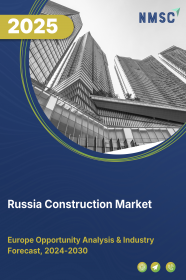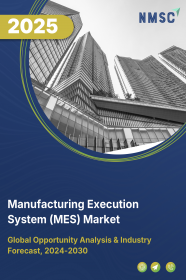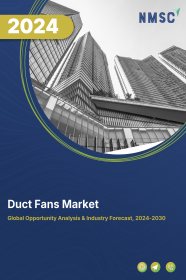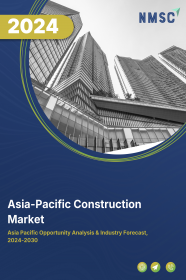
Russia Construction Market by Type (Renovation and New Construction), and by Sector (Real Estate, Infrastructure, and Industrial)–Opportunity Analysis and Industry Forecast, 2024–2030
Industry: Construction & Manufacturing | Publish Date: 27-Dec-2024 | No of Pages: 143 | No. of Tables: 108 | No. of Figures: 53 | Format: PDF | Report Code : CM2208
US Tariff Impact on Russia Construction Market
Trump Tariffs Are Reshaping Global Business
Russia Construction Market Overview
The Russia Construction Market size was valued at USD 185.87 billion in 2023, and is predicted to reach USD 227.58 billion by 2030, at a CAGR of 3.6% from 2024 to 2030.
The construction market, often referred to as infrastructure, is a cornerstone of the economy, overseeing the entire lifecycle of diverse physical structures, including infrastructure, buildings, and facilities. This sector encompasses a broad spectrum of projects, spanning residential, commercial, and industrial developments, as well as civil engineering and institutional infrastructure endeavors.
Collaboration among stakeholders, including architects, engineers, contractors, suppliers, developers, investors, and government agencies, is integral to its functioning. Positioned for growth, the industry is being propelled by an increased focus on environmentally sustainable practices, such as the adoption of green building materials and energy-efficient designs. Additionally, factors such as the rise in per capita income in emerging economies and low-interest rates in developed nations are anticipated to further drive the expansion of the infrastructure market.
Infrastructure Developments is Driving Market Growth
The construction market in Russia is witnessing substantial growth, propelled by the surge of large-scale infrastructure developments. Noteworthy projects in 2023, such as the Vidnoye Residential Complex, Pride Residential Complex, Transport Hub Development, Khasavyurt Bypass, and Pyatigorsk Beshtaugorskoe Highway Reconstruction, significantly contributed to the expansion of the industry within the country. These infrastructural endeavors underscore Russia's commitment to modernization and economic progress.
Government-Led Initiatives is Fueling Growth of the Market
The construction market in Russia is experiencing significant expansion driven by a surge in infrastructure activities and government-led initiatives. According to a report by the International Trade Administration (ITA), the Russian government has invested USD 100.47 billion in a six-year modernization plan aimed at enhancing the country's highways, airports, railways, ports, and other transportation infrastructure by 2024.
The primary objectives of this initiative include improving connectivity between different regions of Russia and developing key road routes, such as the Europe-Western China transport corridor and the Northern Sea Route. This substantial investment reflects the government's dedication to infrastructure development and economic growth in Russia.
Regulatory Complexities Hurdles in Market Growth
Navigating regulatory complexities presents a formidable barrier in the construction market. Infrastructure projects often face hurdles due to the intricate network of government regulations and permitting procedures. Infrastructure endeavors require numerous permits and approvals from governmental bodies at local, regional, and national levels.
These mandates encompass adherence to zoning regulations, environmental assessments, compliance with building codes, safety standards, and various regulatory stipulations. The lengthy process of acquiring permits, bureaucratic inefficiencies, and disparities in regulations among different jurisdictions can substantially prolong project timelines and inflate costs. Furthermore, fluctuations in regulations or unexpected policy changes can disrupt ongoing projects and deter potential investments.
Integration of Digitalization and BIM Presents Lucrative Opportunity for Market Expansion
The construction industry is undergoing a transformative phase with the integration of digitalization and the adoption of Building Information Modeling (BIM). Leveraging advanced technologies such as BIM enhances efficiency, accuracy, and collaboration across diverse projects.
BIM, a sophisticated 3D modeling tool, empowers stakeholders to generate and manage digital representations of structures and infrastructure, facilitating improved coordination and communication among project teams. For example, in September 2022, the National Institute of Building Sciences (NIBS) initiated the Russia National Building Information Management (BIM) Program.
This program aims to revolutionize the infrastructure sector, achieving unprecedented levels of industrial efficiency through digitalization. By addressing the inadequacy of digitalization within the Russia infrastructure sector, the initiative seeks to streamline lifecycle work processes, making them more efficient, cost-effective, resilient, and safer for infrastructure and maintenance.
Competitive Landscape
The market players operating in the Russia infrastructure industry include PIK Group, HAKA MOSCOW, Velesstroy, Moscow Engineering and Construction Company, BOES Construction, ESTA Construction, China State Construction Engineering Corp. Ltd. (CSCEC), China Railway Group Ltd. (CREC), China Railway Construction Corp. Ltd. (CRCC), China Communications Construction Group Ltd. (CCCC), Power Construction Corp. of China, China Energy Engineering Corporation (CEEC), Shanghai Construction Group (SCG), Vinci SA, Bouygues Group, and others.
Russia Construction Market Key Segments
By Type
-
Renovation
-
New Construction
By Sector
-
Real Estate
-
Residential
-
Affordable
-
Luxury
-
-
Commercial
-
Retail Buildings
-
Office Buildings
-
Hospitality
-
Healthcare Facilities
-
Educational Institutes
-
Entertainment Ventures
-
-
-
Infrastructure
-
Transportation
-
Airport
-
Port
-
Rail
-
Road
-
-
Water and Wastewater
-
Energy
-
Telecommunication
-
-
Industrial
-
Manufacturing Plant
-
Warehouses
-
Power Plants
-
Oil Refineries
-
Chemical Plants
-
Key Players
-
PIK Group
-
HAKA MOSCOW
-
Velesstroy
-
Moscow Engineering and Construction Company
-
BOES Construction
-
ESTA Construction
-
China State Construction Engineering Corp. Ltd. (CSCEC)
-
China Railway Group Ltd. (CREC)
-
China Railway Construction Corp. Ltd. (CRCC)
-
China Communications Construction Group Ltd. (CCCC)
-
Power Construction Corp. of China
-
China Energy Engineering Corporation (CEEC)
-
Shanghai Construction Group (SCG)
-
Vinci SA
-
Bouygues Group
REPORT SCOPE AND SEGMENTATION:
|
Parameters |
Details |
|
Market Size in 2023 |
USD 185.87 Billion |
|
Revenue Forecast in 2030 |
USD 227.58 Billion |
|
Growth Rate |
CAGR of 3.6% from 2024 to 2030 |
|
Analysis Period |
2023–2030 |
|
Base Year Considered |
2023 |
|
Forecast Period |
2024–2030 |
|
Market Size Estimation |
Billion (USD) |
|
Growth Factors |
|
|
Companies Profiled |
10 |
|
Market Share |
Available for 10 companies |
|
Customization Scope |
Free customization (equivalent up to 80 working hours of analysts) after purchase. Addition or alteration to country, regional, and segment scope. |
|
Pricing and Purchase Options |
Avail customized purchase options to meet your exact research needs. |

















 Speak to Our Analyst
Speak to Our Analyst

















